Hoya Kerrii (Sweetheart Plant / Valentine Hoya): Care Guide
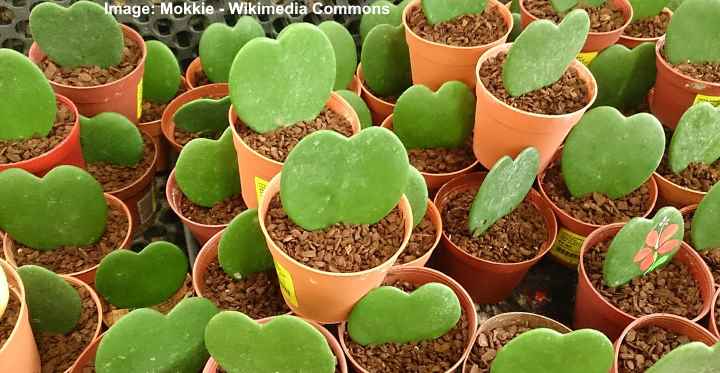
The Hoya kerrii is a cool-looking houseplant due to its heart-shaped leaves and low maintenance requirements. The heart leaves on this species of Hoya are the reason why this plant has common names such as sweetheart plant, lucky-heart plant, and love heart plant. Leaf cuttings growing in small pots are popular gifts on Valentine’s Day to symbolize love and devotion. These heart-shaped plants are succulent and not a cactus, but often called the heart cactus. They are extremely easy to care for as they grow in most indoor environments.
How to care for Hoya kerrii: A sweetheart plant grows in bright direct light, well-draining loose soil, with only occasional watering. Keep these succulent heart plants in a temperature range of 65°F to 80°F (18°C – 27°C) and medium humidity. Fertilize up to four times a year in the growing season.
Hoya heart plants are a species of climbing vine in the genus Hoya—also called wax plants. The thick, succulent heart-shaped leaves grow on long, trailing stems that can reach up to 13 ft. (4 m) long. Each heart leaf is about 2.3” (6 cm) wide, and individual leaves root easily in the soil to create a unique plant in the shape of a heart.
Mature Hoya Kerrii plants are difficult to find. If you find these “lucky heart plants,” they are usually very expensive. Most people have seen sweetheart hoyas growing as a single thick leaf in a small pot. These slow-growing novelty plants rarely grow any larger than the cutting in the pot. You need a stem cutting to propagate a vining Hoya kerrii.
The most common hoya heart plant has bright-green succulent leaves that are in a perfect heart shape. Other Hoya Kerrii cultivars have variegated, green and creamy-yellow leaves. The two most common types of lucky-heart plants are the variegated Sweetheart Hoya and the Hoya Kerrii ‘Reverse Variegata.’ The Hoya kerrii ‘Splash’ has pale green speckles decorating the succulent leaves.
In this article, you will find out how to grow a heartleaf Hoya plant at home. At the end of the article, you will learn how to resolve any growing issues with this cute species of Hoya.
How to Care for Hoya Kerrii (Lucky-Heart) Plant
Although the Sweetheart Hoya is a popular Valentine’s Day gift, this plant can grow for many years. Even though the succulent heart-shaped leaf may grow very slowly, it can sit on a bright windowsill and survive with minimal care. The leaves that are popular around Valentine’s Day are from the mature Hoya kerrii climbing plant.
How Much Light Does Hoya Kerrii Need?
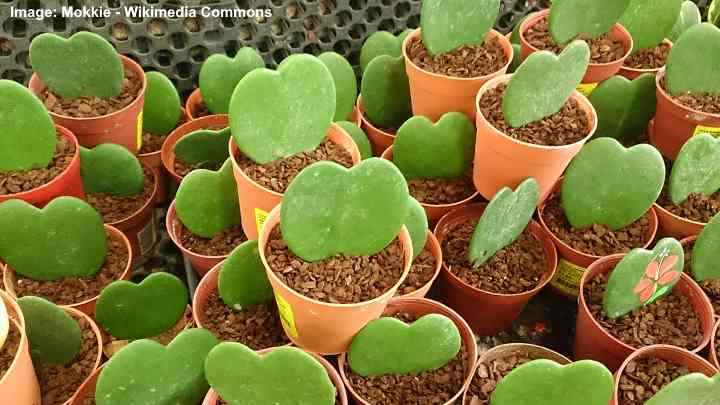
Hoya kerrii has heart shaped leaves hence is also called sweetheart hoya or Valentine hoya. It thrives in bright light.
Being a type of succulent, Sweetheart Hoya plants grow best in bright light, and they can withstand some direct sunshine. However, these heart-shaped plants can also survive in low-light conditions. These slow growers don’t tolerate complete shade, and darkness affects their growth.
Even in bright, indirect light and ideal conditions, Hoya kerrii plants may take years to start growing new heart leaves. So, you need to be patient to keep the plant growing in bright light, but protected from the sun’s direct rays.
If you have variegated types of Sweetheart Hoyas, you will need to place them on a bright windowsill. Adequate light is necessary to keep the variegation on the plump heart leaves vibrant. When the Sweetheart Hoya plant is in the shade for too long, it may start to wilt.
A single leaf Valentine Hoya will not grow any bigger than when you bought it. Even though the leaf cutting roots in the soil, you can’t propagate more Sweetheart Hoyas from a single leaf cutting.
The Best Soil for Growing Hoya Kerrii Indoors

Grow hoya kerrii in well draining soil. In the picture: variegated hoya kerrii with green and creamy yellow leaves
Sweetheart Hoya plants need loose, quickly-draining soil to thrive. The best type of medium for this species of Hoya to grow is orchid pot soil, sphagnum moss, coconut husk or cactus mix. You can also create a potting mix for Hoya kerrii by combining potting soil, perlite, and orchid bark.
When it comes to growing these climbing hoya plants, water should quickly drain through the soil. The appropriate soil for succulent-like plants such as Hoyas needs to have better drainage than for standard houseplants. Sweetheart hoyas—mature plants and single leaf cuttings—need soil that dries out fast.
Hoya kerrii is a species of plant that can grow in a soilless medium. For example, if you use an orchid potting mix, you will have to water the heart leaf vine more often than if you use a potting soil mix. If you have a single leaf Sweetheart Hoya, then a loose, loamy soil that is mostly dry is ideal.
Watering Requirements for Hoya Kerrii to Thrive
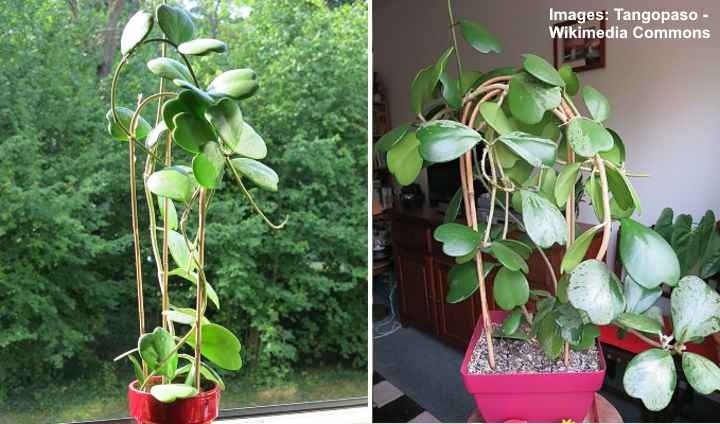
Being a succulent, your hoya heart plant needs infrequent watering. In this image: mature hoya kerrii plants
Sweetheart Hoya plants have succulent leaves that store moisture. So, their watering needs are minimal. However, you should water these sweetheart plants as often as the potting soil dries out. In some cases, this could be every four weeks or even less in the winter. It’s best to drench the soil to hydrate the roots thoroughly.
One sign that your Sweetheart Hoya needs hydration is when the leaves start to wrinkle. However, for your Hoya sweetheart plant to thrive—not just survive—try to use the potting medium as a guide. Check that the soil at the drainage holes is almost dry before giving the plant a thorough soaking.
Allowing the Hoya’s potting mix to dry out between waterings is essential for healthy growth. Sweetheart Hoya plants are prone to root rot if they sit in soggy, waterlogged soil. To ensure vigorous growth in your Hoya kerrii, a fast-draining potting mix along with proper watering is essential.
Indoor Humidity Needs for Sweetheart Plant (Hoya Kerrii)
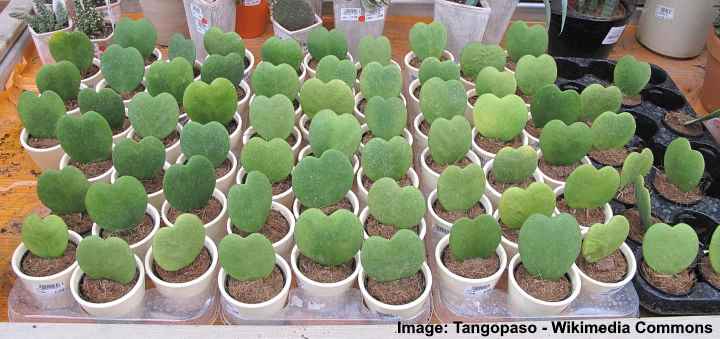
Hoya Kerrii plant grows well in dry air and warm temperatures but humidity over 40% encourages faster growth
Sweetheart Hoyas grow better in humid conditions, unlike many other species of cacti and succulents. Although Hoya Kerrii tolerates dry air and warm temperatures, humidity over 40% encourages faster growth of this notoriously slow-growing plant. Some Hoya experts say that air moisture helps the stem cuttings to root and grow.
Due to their love of warmth and humidity and tolerance for low light, you can grow Hoya Kerrii plants in a bathroom or kitchen. To help increase moisture for Sweetheart Hoyas, use a room humidifier or place the pot on a humidifying pebble tray.
Temperature Range for Growing Sweetheart Wax Plants
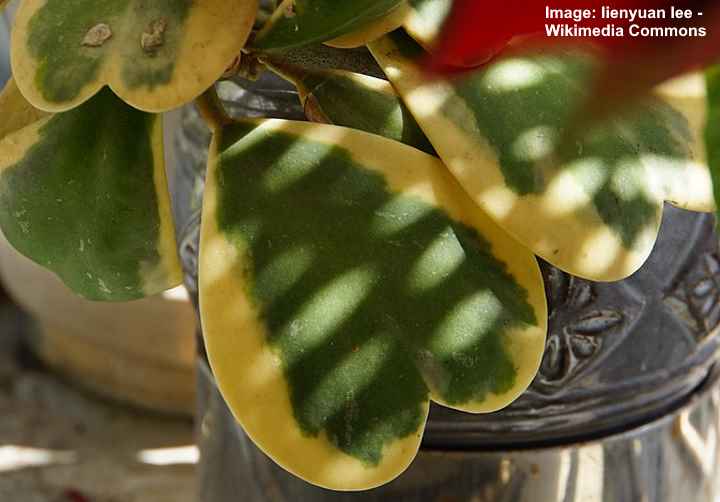
Hoya kerrii grows faster in warmer temperatures. In the picture: Hoya Kerrii ‘Variegata’
Because the Sweetheart plant is on the list of easy-to-grow houseplants, they thrive in average room temperatures. Keep the indoor temperature between 65°F to 80°F (18°C – 27°C) for best growth. Usually, these heart-shaped leaf Hoyas grow faster in warmer temperatures. These succulent-like plants don’t tolerate the cold below 50°F (10°C).
Hoya kerrii plants can grow outdoors in USDA zone 11, where they thrive in warm humidity, similar to their native habitat of Southeast Asia. You can also grow Sweetheart plants in pots outdoors during the summer if you live in temperate climates. However, bring the Hoya plant back indoors when the temperature drops below 60°F (15°C).
Feeding a Hoya Kerrii
Sweetheart Hoyas are light feeders—which is another reason why they are easy houseplants to care for. If you have a mature Hoya kerrii with long stems, you should apply a diluted regular houseplant fertilizer. You only need to feed the Hoya sweetheart once a month.
A small Hoya plant or a single leaf sweetheart plant hardly needs any feeding. At most, you can feed the plant twice a year—once in spring to encourage growth and then in summer.
Hoya Kerrii Propagation
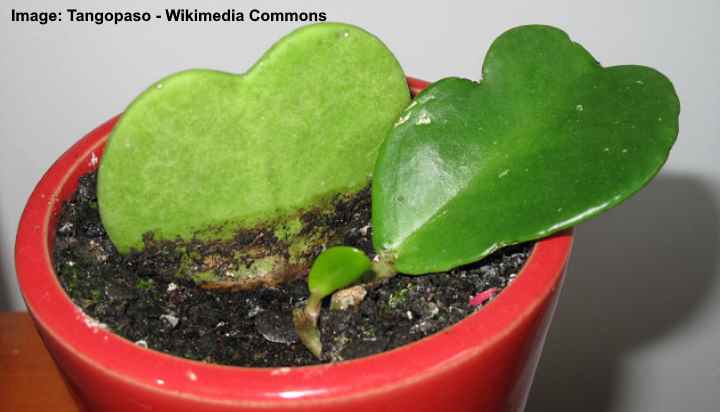
Propagating hoya kerrii is done by stem cutting that has dormant bud. A leaf cutting will rarely produce any stem as it doesn’t have dormant bud
Hoya kerrii are easy houseplants to propagate if you want to grow more sweetheart plants. The best method is by stem cuttings that have at least two heart-shaped leaves on it. You can root the cutting in water and wait until new roots start growing. However, a new stem cutting can take many months to root.
How to Propagate Hoya Kerrii:
- Cut a healthy stem from a Sweetheart Hoya just below the node, making sure there are two or three leaves on it.
- Put the cutting in a jar of water and put it in a bright place, protected from direct sunlight.
- Change the water weekly.
- Within a few weeks, small roots should start to appear from the stem.
- When the roots are 1” to 2” (2.5 to 5 cm) long, transfer to a pot that has a loose, fast-draining potting mix.
It’s good to remember that even when you plant your rooted stem cutting, it will take a long time to grow. It also may take many years before your heart-shaped Hoya plant blooms with porcelain-like flowers.
Some people try to propagate sweetheart hoya from leaf cuttings. However very rarely does a hoya kerrii leaf produce a new stem or other leaves. A single leaf cannot usually be propagated because it doesn’t have a dormant bud to grow new stems. Therefore it is called ‘blind cutting’. The leaf will root, and with proper care, your hoya heart leaf cutting can live for several years without growing a stem and other leaves.
In some occasions, after a few years a leaf cutting will produce a stem, but this is because a tiny bit of stem was attached to the leaf that had a small dormant bud.
Repotting Hoya Kerrii Plants
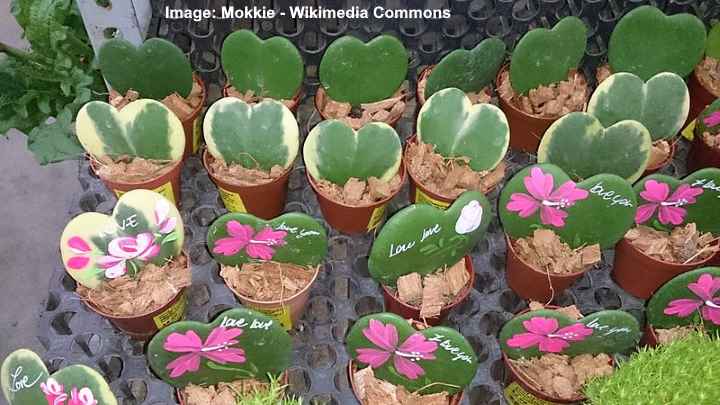
Hoya kerrii is a slow growing plant that only requires infrequent repotting. In the picture: decorated leaves for Valentine’s Day
As a slow growing plant, your hoya kerrii should be repotted every couple of years, using a slightly bigger container each time. Repotting is necessary to encourage your Sweetheart Hoya plant to grow well. As the roots fill up the pot, transferring to a larger container gives the roots more room to grow. However mature vining Hoya kerrii plants need to be rootbound and growing in bright light for them to flower.
When choosing the best type of pot to grow sweetheart plants, there are a few factors to consider. For example, a container that is too large will put the plant at risk of root rot. The potting medium needs to be fast-draining, and large pots hold too much moisture for small plants.
Another factor to consider when repotting Hoya Kerrii sweetheart plants is the pot’s materials. Terracotta or clay pot allows moisture to evaporate rapidly, and the growing medium dries quicker. A plastic or ceramic pot holds moisture, and you don’t need to water so often—however, your plant is at more risk of suffering due to soggy soil.
All you need to do to repot a heart-leaf hoya is to remove it from its existing container. Half-fill a new, slightly larger pot, with appropriate potting mix. Put in the plant and fill the pot with soil.
The best time to repot houseplants—including lucky-heart hoyas—is in the spring, when growth is vigorous. Usually, Hoya kerrii plants need repotting every few years.
A single leaf heart-shaped hoya never needs repotting because the leaf only grows a root system. The hoya heart leaf doesn’t grow any larger when planted in a small pot.
Hoya Kerrii Growth Rate
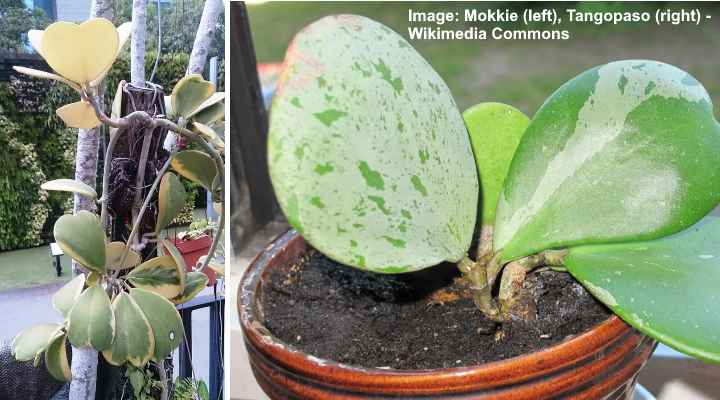
Hoya kerrii are slow grower succulents. Left picture: Hoya kerrii ‘Albomarginata’, right: Hoya kerrii ‘Splash’
Hoya kerrii heart plants are infamous for their painfully slow growth rate. It may take many years for a small plant with a few leaves to grow to maturity. It takes even longer for a mature plant to bloom with its pinkish-white flowers. A Sweetheart Hoya grows faster in a bright location with humidity above 50%.
A mature Hoya kerrii vine with its fleshy, thick, heart-shaped leaves is a stunning plant. The thick stems grow an abundance of heart leaves. Indoors, the stems can grow to around 6 ft. (1.8 m) long. Even more stunning than the standard Sweetheart Hoya is the variegated cultivar, Hoya kerrii albomarginata, with its yellow and bright-green leaves.
Do Hoya Kerrii (Sweetheart Valentine) Plants Flower?
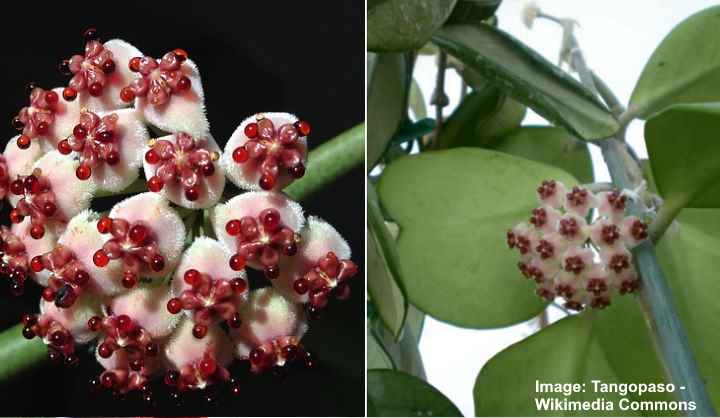
Flowers of mature Hoya kerrii plants
The Sweetheart Hoya plant is a species of tropical flowering plant. Species of Hoyas are also called wax plants or porcelain flower plants due to their beautiful pink and white blooms. Mature plants bloom every summer with clusters of star-shaped flowers. The dainty flowers also give off a pleasant fragrance.
Pests That Can Affect Hoya Kerrii
Most species of Hoyas, including the Sweetheart Hoya, are relatively resistant to pests. However, mealybugs and aphids can sometimes infest your plants. Mealybugs look like bits of cotton wool on the heart-shaped leaves. Aphids are tiny, pear-shaped pests that can suck the life out of your plants.
It is vital to act quickly at the first sign of houseplant pests. You can use a neem oil solution or an insecticidal soap to get rid of your pests. Please read this article to find recipes on how to eliminate plant pests naturally.
Hoya Kerrii Plant Care: How to Prevent Diseases
Being a type of hardy houseplant, Sweetheart Hoyas are generally resistant to disease. Most diseases that afflict a Hoya kerrii are connected with too much moisture in the soil. Roots that sit in soggy soil are prone to fungal and bacterial diseases. Therefore, only water your Sweetheart Hoya as often as the soil dries out.
Related reading: How to get rid of white mold on plant leaves and is plant soil mold dangerous?
Are Hoya Kerrii Plants Toxic?
No, Sweetheart Hoyas are not toxic to cats, dogs, or other pets in the household. (1)
FAQ About Growing Sweetheart Hoyas (Hoyas kerrii)
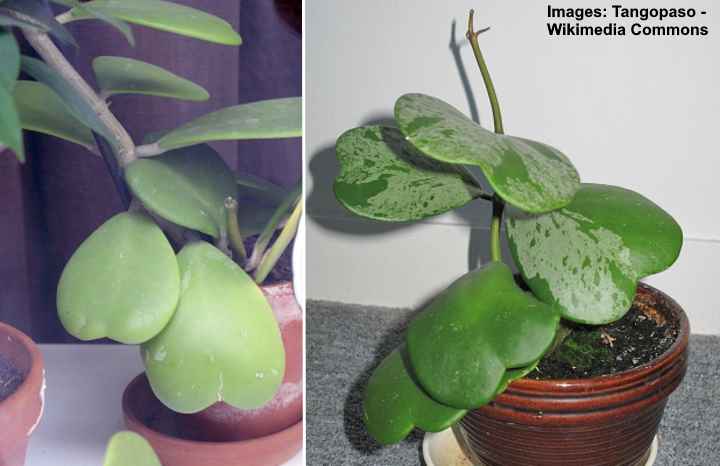
Right image: Hoya kerrii ‘Splash’ with pale green speckles on the heart shaped leaves
What are black spots on Hoya kerrii leaves?
Black or dark green specks on Sweetheart Hoya leaves could be signs of a fungal infection. Several factors can lead to black spot leaf infections. For example, overwatering is a common reason. However, cool temperatures and a humid environment also allow fungal spores to grow.
To help resolve fungal infections, hold off watering until the soil completely dries and put the Hoya in a warm environment.
Why are Sweetheart Hoya leaves turning yellow?
Hoya kerrii leaves can turn yellow because of overwatering or too much direct sunlight. If you are watering your sweetheart plant correctly, try moving your heart-leafed plant out of direct sunlight. On the other hand, variegated Hoya kerrii can lose their yellow colors if left in the sun for too long. In these cases, you’ll end up with mostly green leaves.
How can I save a dying sweetheart plant?
To revive a Hoya kerrii that is wilting and yellowing, you should try to find out the reason for its weak condition. If the hoya heart leaf has been growing in soggy soil, your only choice would be to repot it in fresh, sterile soil that is slightly moist. However, if pests have infested your plant, you’ll need to use neem oil to get rid of the bugs.
Related articles:
